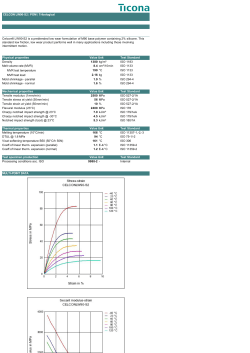
Quality Management 1
Quality Management 1 ISO 9000:2000 What Is Quality? Degree to which a set of inherent characteristics fulfils requirements 2 Quality Techniques & QMS Standards Quality Control Quality Assurance Quality Management (Detection) (Prevention) (Direction) BS 5750 1979-1987 ISO 9001/2/3 1987-2000 ISO 9001 2000 3 What Is A Quality Management System? Planned Individually Implemented Collectively People Processes Materials Equipment Resources Documented System Describes how this happens System “Best Practice” 4 Why Document? • Communication Tool • Manage Change • Aids consistency • Record of Best Practice • Enables Effective Audit • ISO 9001 Pre-requisite 5 Documented Q.M.S. INTENT POLICY QUALITY MANUAL PROCEDURES WHAT? HOW? WHY? LOCAL/WORK INSTRUCTIONS RECORDS / FORMS PROOF 6 ISO 9001:2000 The Structure: ISO 9001 - Q.M.S. Requirements ISO 9004 - Q.M.S. Guidelines on Performance Improvement ISO 9000 - Q.M.S. Fundamentals & Vocabulary 7 4.1 Control Our Processes 4.2 Control Our Documentation 5.3 Policy Objectives 5.4 Determine & Communicate 5.2 Customer Focus 5.5 Authority & Responsibilities 5.1 Committed Review 5.6 Customer 8.2.1 5. Managed Satisfaction 8.2.2 System 8.2.3 Processes 8.2.4 Product 8.3 Non-conforming Product 8.4 Data & Info 8.5.2 Corrective Action 8.5.3 Preventive Action 8. Measure GOOD Analyse COMPANY Improve ISO 6. Provide Resources People 6.2 Buildings, Equipment, Machinery, etc 6.3 Environment 6.4 7. Do What the Customer Wants 7.1 Planning 7.2 Selling 7.3 Designing 7.4 Purchasing Production 7.5 7.6 Calibrating 8 ISO 9001:2000 Based on the 8 Quality Management Principles: 1. Customer Focus 2. Leadership 3. Involvement of People 4. Process Approach 5. System Approach to Management 6. Continual Improvement 7. Factual Approach to Decision Making 8. Mutually Beneficial Supplier Relationships 9 Quality Management Process Model Continual improvement of the quality management system Management Responsibility Customers Customers Resource management Requirements Input Product Realisation Measurement, analysis and improvement Satisfaction Output Product 10 So the Quality Management System (ISO9001) defines what the organization does to ensure that its products or services satisfy the customer's quality requirements and comply with any regulations applicable to those products or services. ISO 14000 is primarily concerned with "environmental management". In plain language, this means what the organization does to minimize harmful effects on the environment caused by its activities. 11 ISO 14001 is an internationally recognised standard for environmental management system which can be applied by any organisation. It has much in common with ISO 9001, in particular the PLAN - DO - CHECK- ACT concept. As a minimum, ISO 14001 requires a commitment to legal compliance, continual improvement and pollution prevention. It involves the identification and assessment of all environmental aspects and impacts in order to determine which are significant. These must then be managed so as to minimise harm to the environment. 12 ISO14001 - Environmental management system model for the international standard Environmental Policy Continual improvement Management Review Checking and Corrective Action •Monitoring and measurement •Non-conformance and corrective and preventative action •Records •EMS audits Planning •Environmental aspects •Legal and other requirements •Objectives and targets •Environmental management programmes Implementation and Operation •Structure and responsibility •Training, awareness and competence •Communication •EMS documentation •Document control •Operational control •Emergency preparedness and response 13 ISO 14001 Fundamental requirements Plan, Do, Check and Act to ensure: • prevention of pollution • compliance with environmental regulations (and RR • Standards) and continual improvement in environmental performance 14 Typical questionnaire for ISO14001 effectiveness: Have all employees received environmental training and been briefed? Are business/corporate objectives and targets communicated to the workforce? Can you show progress towards the achievement of objectives and are the relevant managers and employees aware of their actions in this respect? Is the site in a good general state of housekeeping? Has the HS&E policy been reviewed and is the updated copy available throughout the business? Have any incidents been handled appropriately? 15 Typical questionnaire for ISO14001 effectiveness (continued): Have responsibilities been set for communications with the regulatory bodies? Has there been a test of the emergency plans? Was this documented and plans altered accordingly? Are all maintenance/calibration records fully up to date? Has a management review been undertaken and alterations made to the EMS as necessary? Are all operational procedures up-to-date, readily available and being worked to? 16 Why bother Certificating? External view from trained auditors helps focus attention on the real issues. Impending audits provide “motivation” to do things right. Can be a necessary customer requirement in order to do business. Can give competitive advantage. 17
© Copyright 2025





















